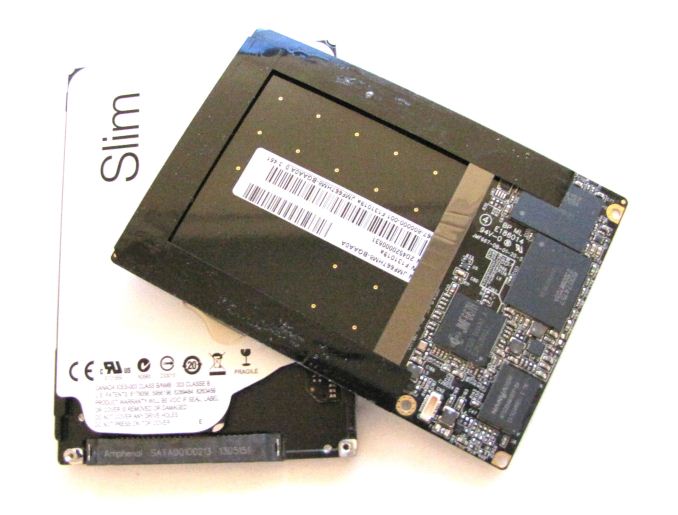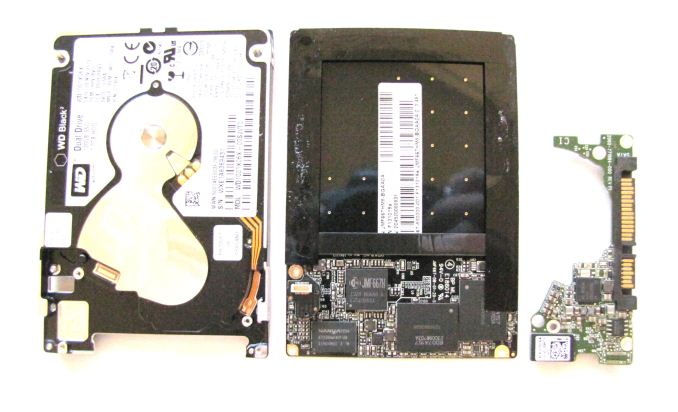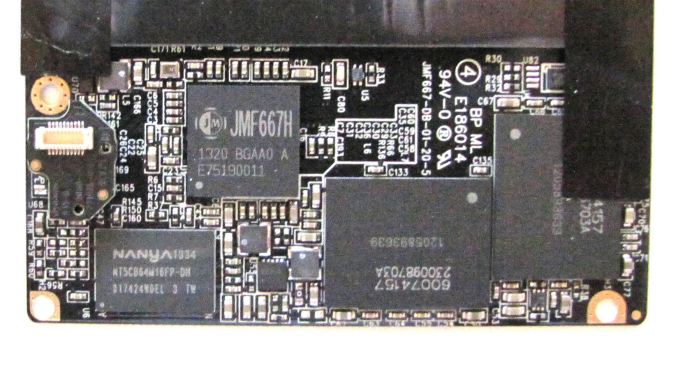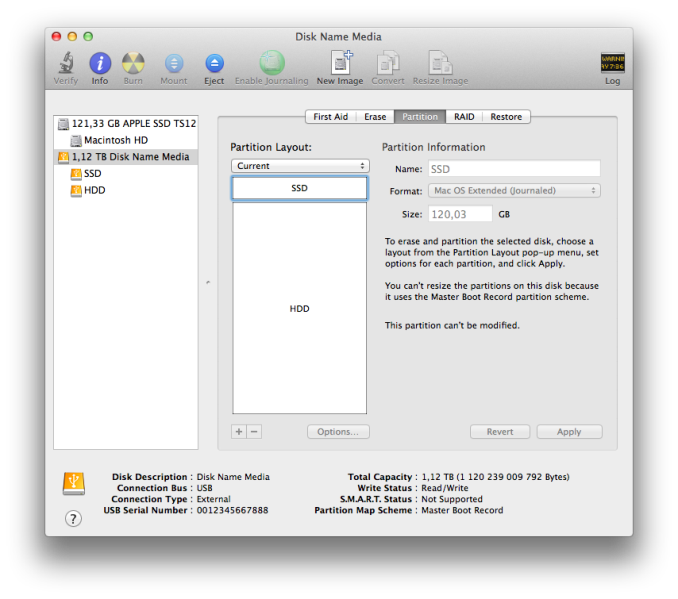The WD Black2 Review: World's First 2.5" Dual-Drive
by Kristian Vättö on January 30, 2014 7:00 AM ESTThe Drive
The Black2 consists of a 120GB SSD and 1TB dual-platter 5400rpm hard drive. It's not a hybrid drive (or SSHD) by definition like the Momentus XT because there's no caching involved. The SSD and hard drive appear as separate partitions, giving the end-user the power to decide what data goes to the SSD and what doesn't. WD calls the Black2 a dual-drive, which is a logical name for the drive because it's fundamentally two drives in one.
(Sorry for the poor quality photos -- I no longer have access to the DSLR I used before)
| WD Black2 Specifications | |
| Interface | SATA 6Gbps |
| Sequential Read | 350MB/s |
| Sequential Write | 140MB/s |
| Power Consumption | 0.9W (idle/standby) / 1.9W (read/write) |
| Noise | 20dBA (idle) / 21dBA (seek) |
| Warranty | 5 years |
| Price | $299 |
Included in the retail package is a USB 3.0 to SATA adapter and Acronis True Image WD Edition (via download) for easy data migration. There is no driver disc to my surprise but a small USB drive, which when plugged in runs a command that sends you to WD's download page (i.e. the actual drivers have to be downloaded).
Internally the drive is rather unique. The hard drive itself is the same as WD's Blue Slim model (7mm dual-platter 5400rpm drive) but in addition to the hard drive, there are two PCBs. The bigger PCB contains the SSD components (controller, NAND, DRAM) and the smaller one is home to Marvell's bridge chip, which allows the SSD and hard drive to utilize the same partition table.
WD went with a rather rare JMicron JMF667H controller in the Black2. It's a 4-channel controller and is based on the ARM9 instruction set, but as usual JMicron doesn't provide much in the way of public details.
JMicron used to be a fairly big player in the consumer SSD space back in ~2009 but the lack of a SATA 6Gbps controller pushed SSD OEMs to go with other manufacturers. The JMF667H isn't JMicron's first SATA 6Gbps controller, although it seems that all the members of JMF66x family are mostly the same with a few tweaks. I've seen the JMF66x controllers used in some Asian brand SSDs (e.g. Transcend SSD740) but the biggest demand for JMF66x has been in the industrial SSD side.
As for the NAND, WD has only disclosed that the NAND is 20nm MLC, suggesting that we're dealing with IMFT NAND (Micron or Intel). I tried googling the part numbers but it appears that the NAND is custom packaged as there was no data to be found. However, I'm guessing we're dealing with 64Gb dies, meaning eight dies (64GB) per package. There's also a 128MB DDR3-1600 chip from Nanya, which acts as a cache for the JMF667H controller.
Setting Up the Black2
When the Black2 is first connected, it appears as a 120GB drive and gaining access to the 1TB hard drive portion requires driver installation. The reason why the driver is required is due to the limits of the SATA protocol. Connecting two drives to a single SATA port would require port multiplication, which isn't supported by all SATA controllers as it's not an official requirement. Most modern SATA controllers do support port multiplication but for instance older Intel and nVidia chipsets don't. It's always better to play it safe and not have any specific hardware requirements, especially as most people have no idea what chipset is in their system.
Once the drivers have been installed, the Black2 will show up as a single drive with two partitions. The way this works is pretty simple. Operating systems use Logical Block Addresses (LBAs) for read/write commands, which are used to keep the data seen in the OS and the data in the drive in sync. As OSes have been designed with hard drives in mind, they use linear addressing, meaning that the LBAs start from 1 (i.e. the outer circle of the hard drive) and increase linearly as more data is written. Partitions are based on LBA ranges and as some of you might remember (and may still do it), splitting a hard drive into two partitions was a way to increase performance because the first partition would get the earliest LBAs with the highest performance.
In the Black2, the earliest LBAs (i.e. 120GB) are assigned for the SSD partition, whereas the rest are for the hard drive. The Marvell chip keeps track of all the LBAs and then sends data to the SSD or hard drive based on the LBA.
Out of interest, I also tried creating a 1120GB volume to see how the drive reacts. It certainly works and I was able to read and write data normally, but the issue is that you lose control of what goes to the SSD and what doesn't. As the earliest LBAs have been assigned to the SSD, the SSD will be filled first and once 120GB has been written the drive moves to writing to the hard drive, meaning that you are pretty much left with the hard drive for anything write related. If you go and delete something that's in the SSD, the next writes will go those SSD LBAs so in theory you could use the Black2 as a single volume drive, but it wouldn't be efficient in any way.
Unofficial Mac Support
The drivers WD provides are Windows only but there is a way, at least in theory, to use the drive in OS X. You need Windows access for this and what you do is set up the partitions in Windows and then use OS X's Disk Utility to format the partitions from NTFS to HFS.
Unfortunately I don't have a Mac with USB 3.0 port to thoroughly test the Black2 in OS X, so this is merely a heads up that it may work. I was able to read and write to the drive normally but without a faster interface I can't test that the writes are indeed going to the SSD when they should be. In theory yes, but it's possible that the drivers include more than just an automated partition set up.
Test System
| CPU | Intel Core i5-2500K running at 3.3GHz (Turbo and EIST enabled) |
| Motherboard | AsRock Z68 Pro3 |
| Chipset | Intel Z68 |
| Chipset Drivers | Intel 9.1.1.1015 + Intel RST 10.2 |
| Memory | G.Skill RipjawsX DDR3-1600 4 x 8GB (9-9-9-24) |
| Video Card | Palit GeForce GTX 770 JetStream 2GB GDDR5 (1150MHz core clock; 3505MHz GDDR5 effective) |
| Video Drivers | NVIDIA GeForce 332.21 WHQL |
| Desktop Resolution | 1920 x 1080 |
| OS | Windows 7 x64 |
Thanks to G.Skill for the RipjawsX 32GB DDR3 DRAM kit
















100 Comments
View All Comments
Kristian Vättö - Thursday, January 30, 2014 - link
There is no official Mac support, so maybe. I just tried using the drive in OS X and added my findings but unfortunately I don't have the tools to properly test it in a Mac.Maltz - Thursday, January 30, 2014 - link
To create a Fusion drive, you have to have two separate devices, not partitions. This drive shows up as a single device.name99 - Friday, January 31, 2014 - link
I don't think that's true. diskutil (in the command line) is crazy tolerant of gluing all sorts of weird shit together. The GUI is much more strict.What you MIGHT have to do if first run
diskutil ar create concat ...
to convert each partition to an AR2 partition. You can then run diskutil cs to fuse these partitions together. As a general principle, whenever diskutil refuses to do something with a raw partition, wrapping it in an AR2 partition will get the job done.
Calinou__ - Thursday, January 30, 2014 - link
This drive is the first Windrive.Panzerknacker - Thursday, January 30, 2014 - link
Very smart and interesting how they designed this. Considering the separation between SSD and HDD happens on LBA level and is based on the partition table, I don't understand why a driver is required though. This should work out of the box. Could you test this a bit more?Xajel - Thursday, January 30, 2014 - link
As they stated, it's a limitation of the SATA protocol, SATA is a point-to-point protocol, means you can't connect more than one device to the same SATA port... there's an un-required extension to the SATA protocol which is called SATA multiplier, basically it's a chip in the other hand of the SATA cable ( of course not in the cable it self ) that will take a single SATA cable and connect it to multiple drives... though it's not available in all chipsets as it's not required...I still hope WD will come with another version with such support, or who knows, maybe a small switch to select between which mode you want, but that will require more space for such switching... but my main concern with these approaches is when one of the drives fails ( after warranty goes )... you will loose a hell !!
In the mean while, I feel the best solution is to find a laptop with both mSATA and 2.5" SATA so you will not worry about one of the drives failing and you loose both...
Panzerknacker - Thursday, January 30, 2014 - link
No this is not true. As they stated, separation between the SSD and HDD happens INSIDE the drive, by means of a system which sends I/0 targeted at the first 120gb of the drive's sectors to the SSD, and I/0 targeted at the rest of the sectors to the HDD. The system in which the Black 2 is installed should see only one 1120GB disk with 2 partitions (default). I don't understand why this would require a driver because the system does NOT know or need to know what's going on inside the drive as long as you don't mess with the default partition layout.DanNeely - Thursday, January 30, 2014 - link
The 2 partitions in one drive thing only happens after the drivers are installed. It's implemented using port multiplication which means that it has 2 different drives hanging off a single sata port. Some older computers didn't come with support for it, so WD used the looks like only a 120GB drive by default kludge for wider spread compatibility.While I understand the need for back compatibility, and wouldn't have a problem if they defaulted to legacy support; I do wish they provided an option either in a configuration app or via a jumper selection that would let it expose itself as a pair of port multiplied drives for systems that do support the feature without having to go through WDs indirection layer.
extide - Thursday, January 30, 2014 - link
Yeah but thats not the case. Panzerknacker is right. If it truly was port multiplication then the computer would see two individual drives. Instead it sees one big one. Theoretically it should be able to work without a driver and show up as a single drive, its kinda like a JBOD of the SSD + HDD built into the drive. That shouldn't need any drivers.Also, is there linux support for this?
Kristian Vättö - Thursday, January 30, 2014 - link
Not officially but once the partitions have been set in Windows they show up fine in Linux and OS X.